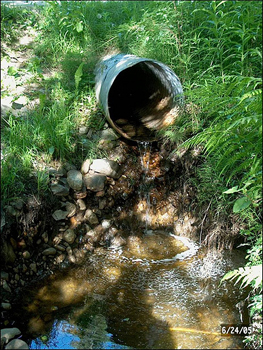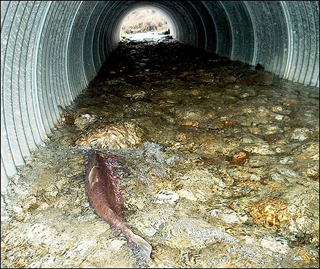Editors note: Congress may invest $475 million this year in Great Lakes cleanup. This story is part of an occasional look at proposals for spending it. Weigh in on this and other ideas or suggest your own on Echo’s Great Lakes Restoration Initiative forum. Other stories.

Culverts like this one can block fish passage. See the rebuilt, fish-friendly passage below. Photo: Partners for Fish and Wildlife, via Flickr
By Allison Bush, bushalli@msu.edu
Great Lakes Echo
July 24, 2009
Old hydropower dams and roadways that cross streams can keep Great Lakes fish from traveling upstream to spawn.
But some also keep invasive species, such as the sea lamprey, from doing the same thing, said Marc Gaden, communications director for the Great Lakes Fishery Commission.
Deciding when such barriers benefit or harm the environment will fall to the U.S Fish and Wildlife Service if it receives $5 million slated for restoring habitats in the Great Lakes.
The allocation is proposed by a government task force recommending how to divvy up $475 million Congress is considering for restoring and protecting the Great Lakes.
The fish and wildlife service has an existing program that improves fish passage needs in the Great Lakes basin. The $5 million boost would double those efforts, said Tim Patronski, Midwest fish passage coordinator for the agency.
The service would get at least $2 million to remove fish passage barriers, he said.
Exactly where the work will be done is not yet decided.
“We have started to coordinate work with state and federal partners on where our priority restoration work will take place, and as we get closer to 2010, we’re going to continue to do that,” he said.
Although there are partial databases about the number of fish passage barriers, the service does not have a good handle on exactly how many there are, Patronski said. There are millions across the country.
And he noted that the money will go to good use restoring the watersheds, but “there’s no way we could address all the needs in the fiscal year.”
The service will have to balance removing fish passage barriers with battling lampreys.

"Bottomless culverts," like this one near Crooked Lake, Ark., let fish navigate streams blocked by roads. Photo: Partners for Fish and Wildlife
“The issue is, if you’re going to remove barriers, do it in a way where you can still deny the lamprey access to the spawning ground, but allow fish to pass,” Gaden said.
This could be done with a barrier that denies the lampreys access, but that fish can easily jump, he said. Or, the fish could go into a fish-way and be passed through manually, he said.
“There’s a lot of work being done on how lamprey barriers could be handled to allow fish passage,” Gaden said.
It is important to remove the barriers for the fish, though, because many fish live in the lakes but spawn in streams, he said.
“The barrier would be denying an upstream habitat, and some would make diversity lower,” he said. “Also, there are some fishermen upstream who would like to see more fish.”
Many of the barriers that prevent fish from passing are up to 60 years old and no longer needed, Patronski said.
“They’re either long abandoned or the owners are unknown or there’s just no money to remove them,” Gaden said.
Part of the $5 million would also be for in-stream and wetland restoration work as well, as the category is considered “habitat restoration.” Species that need their habitat restored from human encroachment include shorebirds, such as the piping plover, said Georgia Parham, a spokeswoman for the Fish and Wildlife Service.
“But one of the biggest challenges in habitat loss is it affects land people are used to,” Parham said. “Of course people want to … recreate on beaches, and we have to find a way to have these things happen at the same time.”
A possible approach could be working with local residents, she said.
“Already, in some communities along the Great Lakes, we have volunteers from the community help protect nests,” Parham said. “For example, people will keep their dogs on leashes during nesting season, or will flag areas where the birds are nesting.”
Is this a good use of the $475 million Congress may spend on Great Lakes restoration? Let us know on Echo’s Great Lakes Restoration Initiative forum.